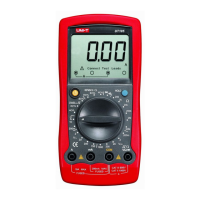
Do you have a question about the UNI-T UT105 and is the answer not in the manual?
| Product type | Digital multimeter |
|---|---|
| AC voltage range | 2 - 750 V |
| DC current range | 0.2 - 10 A |
| DC voltage range | 0.2 - 1000 V |
| Dimensions (WxDxH) | 88 x 39 x 179 mm |
| Battery voltage | 9 V |
| Weight | 352 g |
|---|
Essential safety rules for operating the meter, covering case inspection, test leads, and voltage limits.
Continued safety guidelines on servicing, cleaning, battery handling, and environmental conditions.
Safety precautions for working on vehicles, including air bags, ventilation, and tool placement.
Procedures for connecting/cutting off components and general advice on visual inspection before diagnostics.
Further checks for ignition leads, vacuum hoses, leads, and circuit connections during automotive servicing.
Procedure to check if a fuse is blown out by measuring its resistance.
Method to test if a switch is working correctly by checking resistance when connected and disconnected.
Procedure for testing the impedance of solenoids or relay coils, noting potential limitations.
Overview of testing engine starting and charging systems, highlighting the multimeter's role.
Test battery power consumption with the engine off to identify additional current draw.
Test the battery's ability to provide adequate voltage upon engine start.
Test voltage drops across components to diagnose issues affecting engine start.
